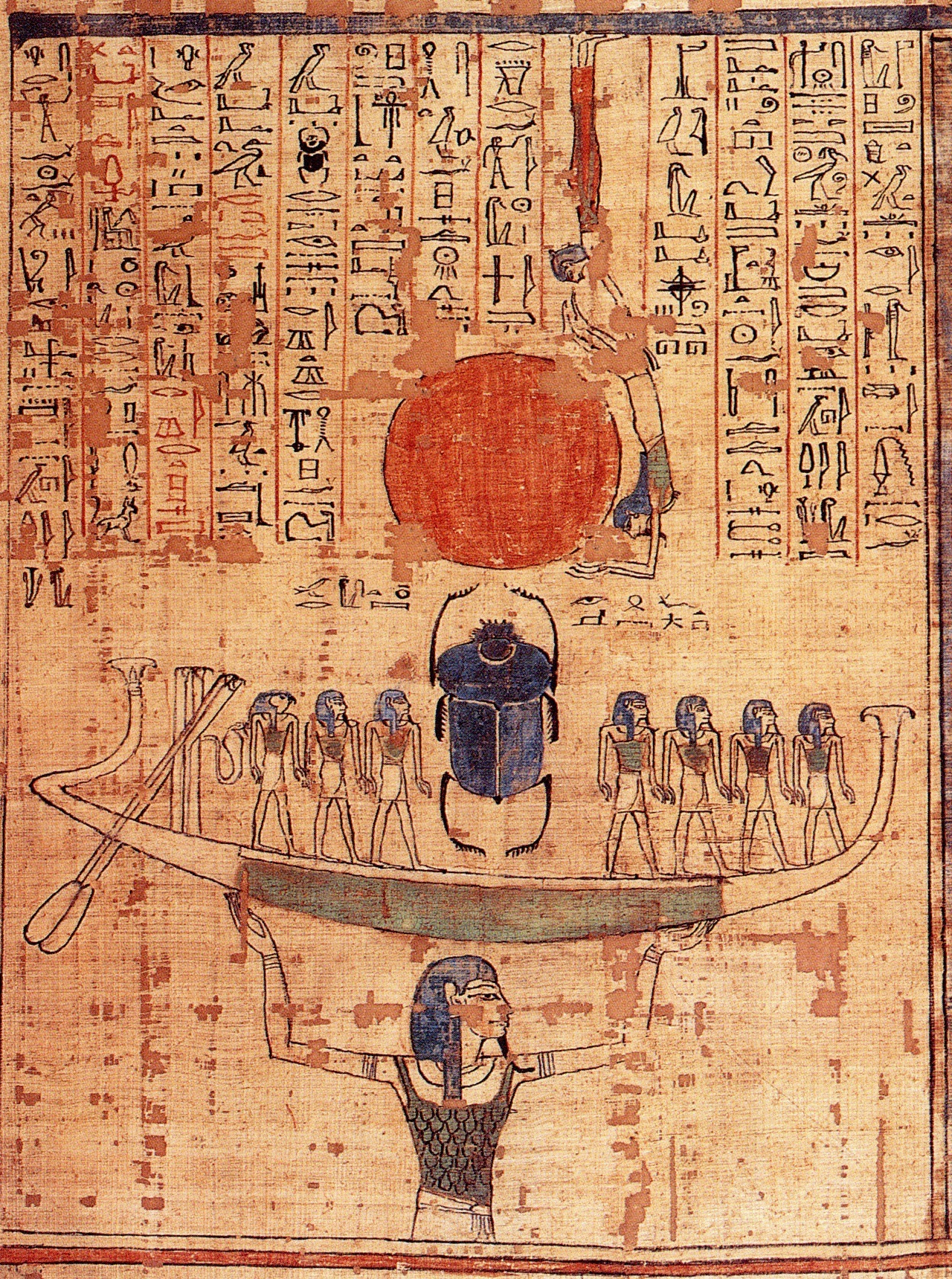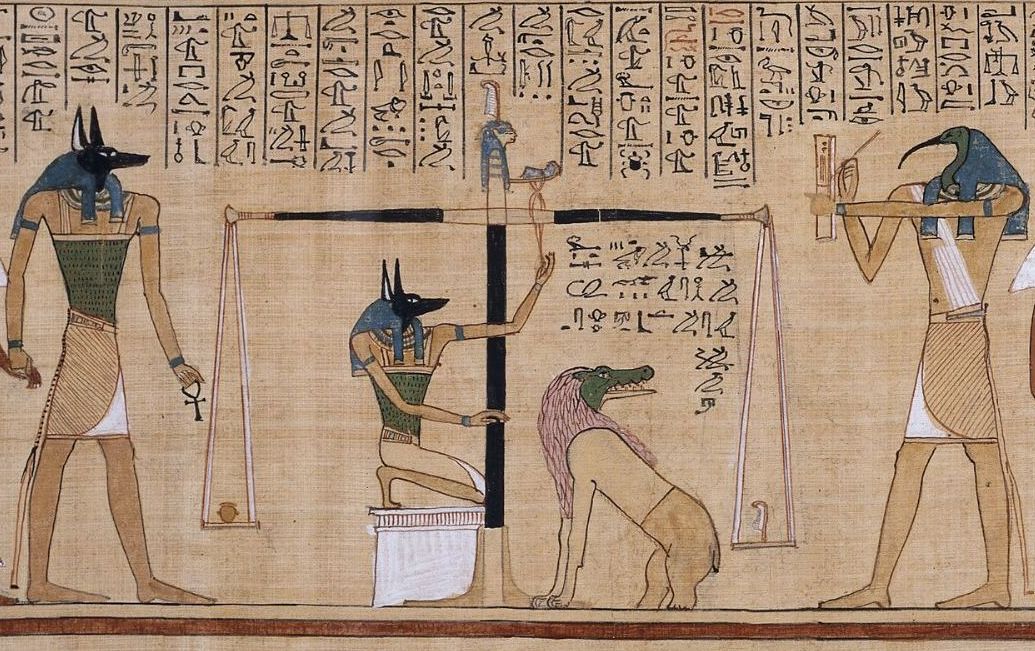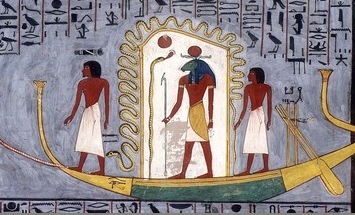|
Book Of Traversing Eternity
The Book of Traversing Eternity is an ancient Egyptian funerary text used primarily in the Roman period of Egyptian history (30 BC – AD 390). The earliest known copies date to the preceding Ptolemaic Period (332–30 BC), making it most likely that the book was composed at that time.Hornung, Erik (1999). ''The Ancient Egyptian Books of the Afterlife'', Cornell University Press, pp. 151–152 The book describes the deceased soul as visiting temples in Egypt and participating in the cycle of periodic religious rituals, particularly those related to the funerary god Osiris. Some scholars have seen the book's content as a description of the Duat, similar to the "underworld books" from the New Kingdom (c. 1550–1070 BC). Others, such as Jan Assmann, have argued that the book describes the deceased as joining with the religious community of the living. Erik Hornung says that in the ''Book of Traversing Eternity'' "the realm of the dead was brought into this life, and this other-wor ... [...More Info...] [...Related Items...] OR: [Wikipedia] [Google] [Baidu] |
Ancient Egyptian Funerary Text
The literature that makes up the ancient Egyptian funerary texts is a collection of religious documents that were used in ancient Egypt, usually to help the spirit of the concerned person to be preserved in the afterlife. They evolved over time, beginning with the Pyramid Texts in the Old Kingdom through the Coffin Texts of the Middle Kingdom and into several books, most famously the Book of the Dead, in the New Kingdom and later times. Old Kingdom The funerary texts of the Old Kingdom were initially reserved for the king only. Towards the end of the period, the texts appeared in the tombs of royal wives. Middle Kingdom These are a collection of ancient Egyptian funerary spells written on coffins beginning in the First Intermediate Period. Nearly half of the spells in the Coffin Texts derive from those in the Pyramid Texts. New Kingdom *Book of the Dead *Amduat *Spell of the Twelve Caves *The Book of Gates *Book of the Netherworld *Book of Caverns *Book of the Earth *Litany o ... [...More Info...] [...Related Items...] OR: [Wikipedia] [Google] [Baidu] |
Jan Assmann
Jan Assmann (born Johann Christoph Assmann; born 7 July 1938) is a German Egyptologist. Life and works Assmann studied Egyptology and classical archaeology in Munich, Heidelberg, Paris, and Göttingen. In 1966–67, he was a fellow of the German Archaeological Institute in Cairo, where he continued as an independent scholar from 1967 to 1971. After completing his habilitation in 1971, he was named a professor of Egyptology at the University of Heidelberg in 1976, where he taught until his retirement in 2003. He was then named an ''Honorary Professor of Cultural Studies'' at the University of Constance, where he is today. In the 1990s, Assmann and his wife Aleida Assmann developed a theory of cultural and communicative memory that has received much international attention. He is also known beyond Egyptology circles for his interpretation of the origins of monotheism, which he considers as a break from earlier cosmotheism, first with Atenism and later with the Exodus from Egypt of ... [...More Info...] [...Related Items...] OR: [Wikipedia] [Google] [Baidu] |
Eternity
Eternity, in common parlance, means Infinity, infinite time that never ends or the quality, condition, or fact of being everlasting or eternal. Classical philosophy, however, defines eternity as what is timeless or exists outside time, whereas sempiternity corresponds to infinite Duration (philosophy), duration. Philosophy Classical philosophy defines eternity as what exists outside time, as in describing timeless supernatural beings and forces, distinguished from sempiternity which corresponds to infinite time, as described in requiem prayers for the dead. Some thinkers, such as Aristotle, suggest the Eternity of the world, eternity of the natural cosmos in regard to both past and future eternal duration. Boethius defined eternity as "simultaneously full and perfect possession of interminable life". Thomas Aquinas believed that God's eternity does not cease, as it is without either a beginning or an end; the concept of eternity is of divine simplicity, thus incapable of be ... [...More Info...] [...Related Items...] OR: [Wikipedia] [Google] [Baidu] |
Egyptian Mythology
Egyptian mythology is the collection of myths from ancient Egypt, which describe the actions of the Egyptian gods as a means of understanding the world around them. The beliefs that these myths express are an important part of ancient Egyptian religion. Myths appear frequently in Egyptian writings and art, particularly in short stories and in religious material such as hymns, ritual texts, funerary texts, and temple decoration. These sources rarely contain a complete account of a myth and often describe only brief fragments. Inspired by the cycles of nature, the Egyptians saw time in the present as a series of recurring patterns, whereas the earliest periods of time were linear. Myths are set in these earliest times, and myth sets the pattern for the cycles of the present. Present events repeat the events of myth, and in doing so renew ''maat'', the fundamental order of the universe. Amongst the most important episodes from the mythic past are the creation myths, in which the ... [...More Info...] [...Related Items...] OR: [Wikipedia] [Google] [Baidu] |
UCLA
The University of California, Los Angeles (UCLA) is a public land-grant research university in Los Angeles, California. UCLA's academic roots were established in 1881 as a teachers college then known as the southern branch of the California State Normal School (now San José State University). This school was absorbed with the official founding of UCLA as the Southern Branch of the University of California in 1919, making it the second-oldest of the 10-campus University of California system (after UC Berkeley). UCLA offers 337 undergraduate and graduate degree programs in a wide range of disciplines, enrolling about 31,600 undergraduate and 14,300 graduate and professional students. UCLA received 174,914 undergraduate applications for Fall 2022, including transfers, making the school the most applied-to university in the United States. The university is organized into the College of Letters and Science and 12 professional schools. Six of the schools offer undergraduate degre ... [...More Info...] [...Related Items...] OR: [Wikipedia] [Google] [Baidu] |
Book Of The Dead
The ''Book of the Dead'' ( egy, 𓂋𓏤𓈒𓈒𓈒𓏌𓏤𓉐𓂋𓏏𓂻𓅓𓉔𓂋𓅱𓇳𓏤, ''rw n(y)w prt m hrw(w)'') is an ancient Egyptian funerary text generally written on papyrus and used from the beginning of the New Kingdom (around 1550 BCE) to around 50 BCE. The original Egyptian name for the text, transliterated ''rw nw prt m hrw'', is translated as ''Book of Coming Forth by Day'' or ''Book of Emerging Forth into the Light''. "Book" is the closest term to describe the loose collection of texts consisting of a number of magic spells intended to assist a dead person's journey through the ''Duat'', or underworld, and into the afterlife and written by many priests over a period of about 1,000 years. Karl Richard Lepsius introduced for these texts the German name ''Todtenbuch'' (modern spelling ''Totenbuch''), translated to English as Book of the Dead. The ''Book of the Dead'', which was placed in the coffin or burial chamber of the deceased, was part of a trad ... [...More Info...] [...Related Items...] OR: [Wikipedia] [Google] [Baidu] |
Classical Antiquity
Classical antiquity (also the classical era, classical period or classical age) is the period of cultural history between the 8th century BC and the 5th century AD centred on the Mediterranean Sea, comprising the interlocking civilizations of ancient Greece and ancient Rome known as the Greco-Roman world. It is the period in which both Greek and Roman societies flourished and wielded huge influence throughout much of Europe, North Africa, and Western Asia. Conventionally, it is taken to begin with the earliest-recorded Epic Greek poetry of Homer (8th–7th-century BC), and continues through the emergence of Christianity (1st century AD) and the fall of the Western Roman Empire (5th-century AD). It ends with the decline of classical culture during late antiquity (250–750), a period overlapping with the Early Middle Ages (600–1000). Such a wide span of history and territory covers many disparate cultures and periods. ''Classical antiquity'' may also refer to an idealized v ... [...More Info...] [...Related Items...] OR: [Wikipedia] [Google] [Baidu] |
New Kingdom
New is an adjective referring to something recently made, discovered, or created. New or NEW may refer to: Music * New, singer of K-pop group The Boyz Albums and EPs * ''New'' (album), by Paul McCartney, 2013 * ''New'' (EP), by Regurgitator, 1995 Songs * "New" (Daya song), 2017 * "New" (Paul McCartney song), 2013 * "New" (No Doubt song), 1999 *"new", by Loona from '' Yves'', 2017 *"The New", by Interpol from ''Turn On the Bright Lights'', 2002 Acronyms * Net economic welfare, a proposed macroeconomic indicator * Net explosive weight, also known as net explosive quantity * Network of enlightened Women, a conservative university women's organization * Next Entertainment World, a South Korean film distribution company Identification codes * Nepal Bhasa language ISO 639 language code * New Century Financial Corporation (NYSE stock abbreviation) * Northeast Wrestling, a professional wrestling promotion in the northeastern United States Transport * New Orleans Lakefront Ai ... [...More Info...] [...Related Items...] OR: [Wikipedia] [Google] [Baidu] |
Egypt (Roman Province)
, conventional_long_name = Roman Egypt , common_name = Egypt , subdivision = Roman province, Province , nation = the Roman Empire , era = Late antiquity , capital = Alexandria , title_leader = Praefectus Augustalis , image_map = Roman Empire - Aegyptus (125 AD).svg , image_map_caption = Province of Aegyptus in AD 125 , year_start = 30 BC , event_start = Conquest of Ptolemaic Kingdom , event1 = Formation of the Diocese of Egypt, Diocese , date_event1 = 390 , year_end = 641 , event_end = Muslim conquest of Egypt, Muslim conquest , life_span = 30 BC – 641 AD , stat_year1 = 1st century AD , stat_pop1 = . , today = Egypt , p1 = Ptolemaic Kingdom , flag_p1 = Ptolemaic-Empire 200bc.jpg , s1 = Sasanian Egypt , flag_s1 = Derafsh Kaviani flag of the late Sassanid Empire.svg , s2 = Rashidun Caliphate , flag_s2 = Mohammad adil-Rashidun-empire-at-its-peak-close.PNG , demon ... [...More Info...] [...Related Items...] OR: [Wikipedia] [Google] [Baidu] |
Duat
The Duat ( egy, dwꜣt, Egyptological pronunciation "do-aht", cop, ⲧⲏ, also appearing as ''Tuat'', ''Tuaut'' or ''Akert'', ''Amenthes'', ''Amenti'', or ''Neter-khertet'') is the realm of the dead in ancient Egyptian mythology. It has been represented in hieroglyphs as a star-in-circle: 𓇽. The god Osiris was believed to be the lord of the underworld. He was the first mummy as depicted in the Osiris myth and he personified rebirth and life after death. The underworld was also the residence of various other gods along with Osiris. The geography of the ''Duat'' is similar in outline to the world the Egyptians knew: There are realistic features like rivers, islands, fields, lakes, mounds and caverns, but there were also fantastic lakes of fire, walls of iron, and trees of turquoise. In the ''Book of Two Ways'' (a Coffin Text) there is even a map-like image of the ''Duat''. Resident souls, gods, and demons The ''Duat'' was also a residence for various gods, including Osiri ... [...More Info...] [...Related Items...] OR: [Wikipedia] [Google] [Baidu] |
Osiris
Osiris (, from Egyptian ''wsjr'', cop, ⲟⲩⲥⲓⲣⲉ , ; Phoenician: 𐤀𐤎𐤓, romanized: ʾsr) is the god of fertility, agriculture, the afterlife, the dead, resurrection, life, and vegetation in ancient Egyptian religion. He was classically depicted as a green-skinned deity with a pharaoh's beard, partially mummy-wrapped at the legs, wearing a distinctive atef crown, and holding a symbolic crook and flail. He was one of the first to be associated with the mummy wrap. When his brother, Set cut him up into pieces after killing him, Osiris' wife Isis found all the pieces and wrapped his body up, enabling him to return to life. Osiris was widely worshipped until the decline of ancient Egyptian religion during the rise of Christianity in the Roman Empire. Osiris was at times considered the eldest son of the earth god Geb and the sky goddess Nut, as well as being brother and husband of Isis, and brother of Set, Nephthys, and Horus the Elder, with Horus the Younger ... [...More Info...] [...Related Items...] OR: [Wikipedia] [Google] [Baidu] |



.jpg)

